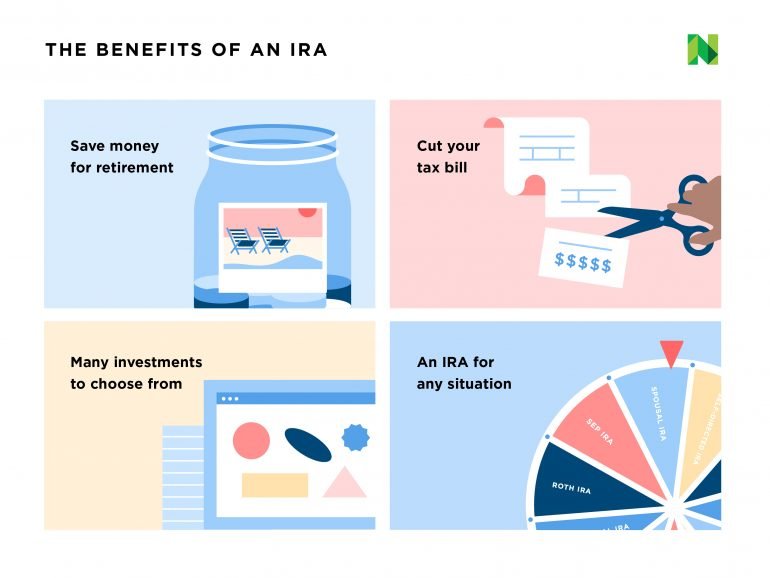An individual retirement account offers tax advantages for retirement savers. Here’s how IRAs work.

Many or all of the products featured here are from our partners who compensate us. This may influence which products we write about and where and how the product appears on a page. However, this does not influence our evaluations. Our opinions are our own. Here is a list of our partners and here’s how we make money.
The investing information provided on this page is for educational purposes only. NerdWallet does not offer advisory or brokerage services, nor does it recommend or advise investors to buy or sell particular stocks, securities or other investments.
What is an IRA?
An individual retirement account (IRA) is a tax-deferred investment account that helps you save for retirement. There are four popular types of IRAs — traditional, Roth, SEP and SIMPLE — and all offer tax benefits that reward you for saving. You can open an IRA at banks, robo-advisors and brokers, and your contributions may be tax-deductible, or withdrawals may be tax-free.
Some people might hear IRA and think Irish Republican Army, that’s not what we’re talking about here. We’re describing the retirement accounts the IRS officially calls individual retirement arrangements.
How do IRAs work?
Investing in an IRA allows your money to grow and compound, says certified financial planner Matt Aaron, founder of Washington, D.C.-based Lux Wealth Planning, an affiliate of Northwestern Mutual. You can invest in stocks, bonds and other assets. How your account balance grows over time depends on how you invest and how much you contribute to the IRA. (See how to invest your IRA for simple investment strategies.)
“You have to always take into consideration your financial situation and risk tolerance, but anybody who doesn’t need the money in the next five years, should be more equity-oriented,” Aaron says. That means investing in stocks and having an IRA.
“That’s the way you outperform inflation,” he says.
IRAs have annual contribution limits. Generally, you (or your spouse) must have earned income to contribute to an IRA. There are withdrawal rules. You may face a 10% penalty and a tax bill if you withdraw money before age 59 1/2, unless you qualify for an exception.
» Are you on track for retirement? Check our retirement calculator
What are the types of IRAs?
There are four popular types of IRAs: traditional, Roth, SEP and SIMPLE. Here’s an overview:
Traditional IRA
Contributions to traditional IRAs are often tax-deductible. For example, contributing $3,000 to a traditional IRA could reduce the amount of your taxable income by $3,000. However, withdrawals from traditional IRAs in retirement are taxable as ordinary income. The contribution limit for traditional IRAs in 2021 and 2022 is $6,000 per year. People 50 and older can contribute up to $7,000 per year
.If you’re married and you or your spouse has a retirement plan at work, the amount of your traditional IRA contribution that you can deduct is reduced, or eliminated altogether, once you hit a certain income. You can still make contributions, but they won’t be tax-deductible. If you and your spouse don’t have retirement plans at work, then you can deduct your IRA contribution no matter how much your income.
Traditional IRA deduction limits in 2021 and 2022
How much of your traditional IRA contributions can you deduct from your taxes? These income limits apply only if you (or your spouse) have a retirement plan at work.
Filing status | 2021 MAGI | 2022 MAGI | Deduction limit |
|---|---|---|---|
Single or head of household (and covered by retirement plan at work) | $66,000 or less | $68,000 or less | Full deduction |
More than $66,000 but less than $76,000 | More than $68,000 but less than $78,000 | Partial deduction | |
$76,000 or more | $78,000 or more | No deduction | |
Married filing jointly (and covered by retirement plan at work) | $105,000 or less | $109,000 or less | Full deduction |
More than $105,000 but less than $125,000 | More than $109,000 but less than $129,000 | Partial deduction | |
$125,000 or more | $129,000 or more | No deduction | |
Married filing jointly (spouse covered by retirement plan at work) | $198,000 or less | $204,000 or less | Full deduction |
More than $198,000 but less than $208,000 | More than $204,000 but less than $214,000 | Partial deduction | |
$208,000 or more | $214,000 or more | No deduction | |
Married filing separately (you or spouse covered by retirement plan at work) | Less than $10,000 | Less than $10,000 | Partial deduction |
$10,000 or more | $10,000 or more | No deduction |
Generally, you can take distributions from a traditional IRA starting at age 59 1/2. If you take money out before then, you may have to pay a 10% penalty (there are some exceptions). You must start taking required minimum distributions when you reach age 70 1/2 or 72, depending on your birthday.
Roth IRA
2021 Standard Deductions
Contributions to Roth IRAs are not tax-deductible, but withdrawals from Roth IRAs are tax-free and there are no taxes on investment gains. It’s an attractive option for investors who have a long time before they retire, Aaron says.
“The question is, do you want to pay your taxes now or later? For me, I’d rather pay taxes now,” he says.
He thinks of a Roth IRA as paying taxes on the seed vs. paying taxes on the harvest.
“I don’t have the magic ball and I can never say I know what’s going to happen in the future, but if taxes go up, and you’re taking that money out in the future, you get to potentially minimize the taxes you pay.”
In 2021 and 2022, the annual contribution limit is $6,000 ($7,000 if 50 or older) for modified adjusted gross incomes below $140,000 for single filers and head of household in 2021 ($144,000 in 2022) or $208,000 for people married filing jointly ($214,000 in 2022).
The amount you can contribute phases out depending on how much you earn.
Do you qualify for a Roth?
Filing status | 2021/2022 MAGI | Maximum annual contribution |
|---|---|---|
Single, head of household or married filing separately (if you didn’t live with spouse during year) | 2021: Less than $125,000 2022: Less than $129,000 | $6,000 ($7,000 if 50 or older) |
2021: $125,000 up to $140,000 2022: $129,000 up to $144,000 | Contribution is reduced | |
2021: $140,000 or more 2022: $144,000 or more | No contribution allowed | |
Married filing jointly or qualifying widow(er) | 2021: Less than $198,000 2022: Less than $204,000 | $6,000 ($7,000 if 50 or older) |
2021: $198,000 up to $208,000 2022: $204,000 up to $214,000 | Contribution is reduced | |
2021: $208,000 or more 2022: $214,000 or more | No contribution allowed | |
Married filing separately (if you lived with spouse at any time during year) | 2021: Less than $10,000 2022: Less than $10,000 | Contribution is reduced |
2021: $10,000 or more 2022: $10,000 or more | No contribution allowed |
SEP IRA
Generally, SEP IRAs are IRAs for self-employed people or small-business owners with few or no employees. Similar to traditional IRAs, the contributions are tax-deductible. Investments grow tax-deferred until retirement when distributions are taxed as income.
In 2022, contributions are limited to 25% of compensation or $61,000, whichever is less. In 2021, the limit was 25% of compensation or $58,000. There’s no catch-up contribution at age 50+ for SEP IRAs, and SEP IRAs require minimum distributions beginning at age 72. SEP IRAs require proportional contributions for each eligible employee if business owners contribute for themselves.
SIMPLE IRA
SIMPLE IRAs (Savings Incentive Match Plan for Employees Individual Retirement Accounts) are for small businesses with fewer than 100 employees. Similar to traditional IRAs, the contributions are tax-deductible. Investments grow tax-deferred until retirement when distributions are taxed as income. Employee contribution limits for a SIMPLE IRA in 2022 are $14,000 per year ($13,500 in 2021) for those under age 50. People age 50 and older can make an additional $3,000 catch-up contribution. Employer contributions are mandatory.
Rollover IRA
A rollover IRA is when you transfer eligible assets from an employer sponsored plan, like a 401(k), into an IRA.
» MORE: Learn more about rollover IRAs
The benefits of an IRA
“The main benefit of an IRA is your ability to have more investment options and choices,” says Aaron, the certified financial planner.
A 401(k) or pension may not provide enough retirement income. Putting the maximum contribution amount in an IRA can help you prepare for retirement, save on taxes and access investment options your workplace retirement plan might not offer.
“There is a lot more flexibility in what you can do,” Aaron says.
And, Aaron says, you can use your IRA money on other things, such as a first-time home purchase, college, or a qualifying disability.

Is it better to have a 401(k) or IRA?
You can have both. You can get the full employer match on your 401(k), and open an IRA to boost your retirement savings.
If you don’t get an employer match, if you plan to max out your 401(k), or if your 401(k) has narrow investment options or high fees, it might be a good idea to invest primarily in an IRA.
The big difference between an IRA and a 401(k) is that employers offer 401(k)s, while you would open an IRA yourself through a broker or bank. As Aaron noted, IRAs typically offer more investment options; 401(k)s allow higher annual contributions.
If you have an old 401(k), you can also move that money into a rollover IRA. A benefit of a rollover IRA is that when done correctly, the money keeps its tax-deferred status and doesn’t trigger taxes or early withdrawal penalties.
» MORE: IRA vs. 401(k): How to Choose
How to open an IRA
Two popular ways to get an IRA are through brokers and robo-advisors.
Brokers: If you want to choose investments for yourself, an online broker can be a good way to go. Review our best IRA accounts to compare.
Robo-advisors: If you want help managing your retirement account, consider a robo-advisor — a service that selects low-cost and risk-appropriate investments for you. See our list of best robo-advisors for help choosing the right one for you.
See our guide to opening an IRA for more information on moving money into your account.
NerdWallet editor Pamela de la Fuente contributed to this report.
NerdWallet writers are subject matter authorities who use primary, trustworthy sources to inform their work, including peer-reviewed studies, government websites, academic research and interviews with industry experts. All content is fact-checked for accuracy, timeliness and relevance. You can learn more about NerdWallet’s high standards for journalism by reading our editorial guidelines.
- 1.IRS. Individual Retirement Arrangements (IRAs). Accessed Apr 3, 2022.
- 2.IRS. What If I Withdraw Money From My IRA?. Accessed Apr 3, 2022.
- 3.IRS. Retirement Topics – IRA Contribution Limits. Accessed Apr 3, 2022.
- 4.IRS. IRS Announces Changes To Retirement Plans For 2022. Accessed Apr 3, 2022.
- 5.IRS. SEP Contribution Limits (including grandfathered SARSEPs). Accessed Apr 3, 2022.
- 6.IRS . Retirement Topics – SIMPLE IRA Contribution Limits. Accessed Apr 3, 2022.
